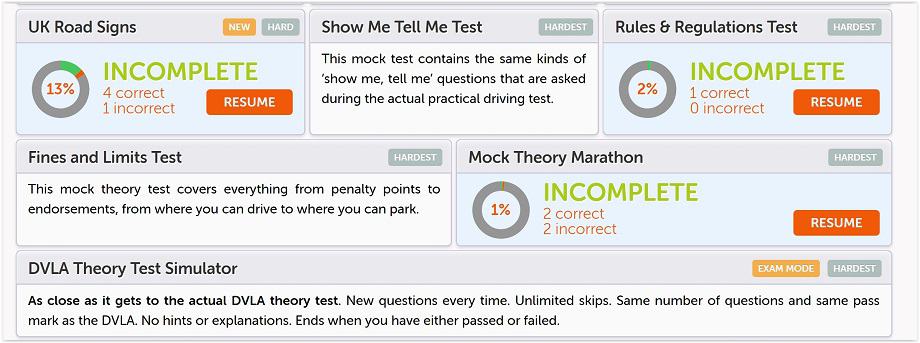Burying your head in the sand until the big day of the test arrives isn’t going to work. And although you may think spending whole days with your head stuck in a revision book will help, none of it is going to soak in if you’re distracted and taking regular breaks for Netflix, Instagram and Candy Crush.
1
57 min
to answer 50 questions
Know the format
Many people get a disappointing result the first time they take their theory test because they don’t know what to expect.
Under the current format, you’ll be given 57 minutes to answer 50 multiple-choice questions.
This is followed by a hazard perception test, where you need to spot “developing hazards” in the surrounding environment which would force you to change your speed or direction in the real world. The quicker you detect a hazard correctly, the more points you can receive. It’s all about fast reactions here.
2
Know the technology
You’re not going to be using pen and paper for the test -- it’s entirely digitised. There can be an element of surprise for people who don’t know this ahead of time.
The DVSA does give you a warm-up period to get accustomed to the system, and this includes some practice questions. It’s good to know that if you’re not sure of answers to difficult questions, you can “flag” them and return to have another go towards the end of the test.
If you have a Eureka moment and suddenly realise you made a mistake in an earlier question, the system does allow you to go back and rectify your error.
When it comes to the hazard perception test, it’s entirely video based. This is rather unusual, so it’s worth paying close attention to the clip which comes before your first question. Here, you need to click your mouse immediately after you spot a hazard. Although you don’t lose points for getting something wrong, you only get one attempt at each of the 14 clips presented to you. This means you can’t go back and change your answer later on.
Here is your official DVSA guide to hazard perception tests:
3
Time management
On TopTests.co.uk, you can practise answering multiple-choice questions like those seen in theory tests. Our next tip to help you get prepared is to use the stopwatch on your phone to see whether you can manage all 50 questions in 57 minutes. Pacing yourself to answer questions quickly and accurately will work wonders -- and give you a clearer idea of the subject areas which are slowing you down. To really test your mettle, try one of our harder quizzes covering fines, regulations and road signs.
4
Know your revision style
It’s been established by some experts that there are four types of learners out there. Whereas a visual learner will get the most out of their revision by seeing pictures and video (perhaps of road signs or a developing hazard), others may thrive by reading a book about driving theory and summarising the main points they need to remember in writing. Kinaesthetic learners benefit most with hands-on experiences, and auditory learners get the best results by listening to information instead of reading it.
There are questionnaires out there which can help you determine which category you fall into. From here, you can tailor your revision technique to your learning style -- whether this means watching YouTube revision videos, downloading an audio book, or printing off a copy of the Highway Code.
Regardless your learning style make sure you finish with the mock tests.

Toptests.co.uk provides you with free mock tests of all levels of difficulty
5
Clever booking
You don’t want all of your revision efforts to go to waste. Make sure your theory test is booked close to when you’ll be taking your practical. Both tests can have waiting lists, and once you’ve passed your theory, the certificate is only valid for two years.
6
Calm your nerves
Arrive for your theory nice and early, be positive, moderate your breathing and try to make sure your test is at a time of day when you’re most awake and alert. A 9am test could damage your performance if you’re no good in the mornings. Making sure you’re relaxed is important, as unwanted jitters and a heightened sense of tension could cause you to jump the gun on hazard perception tests and click too early. Don’t forget to eat.

Your favourite breakfast can be a game changer
Good luck!


